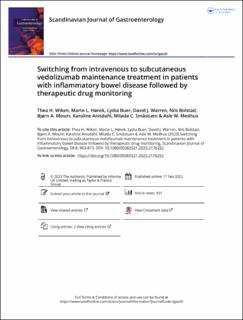| dc.contributor.author | Wiken, Thea H. | |
| dc.contributor.author | Høivik, Marte Lie | |
| dc.contributor.author | Buer, Lydia Celine Tansem | |
| dc.contributor.author | Warren, David J. | |
| dc.contributor.author | Bolstad, Nils | |
| dc.contributor.author | Moum, Bjørn Allan | |
| dc.contributor.author | Anisdahl, Karoline | |
| dc.contributor.author | Småstuen, Milada Cvancarova | |
| dc.contributor.author | Medhus, Asle Wilhelm | |
| dc.date.accessioned | 2023-08-29T11:23:08Z | |
| dc.date.available | 2023-08-29T11:23:08Z | |
| dc.date.created | 2023-06-08T14:08:45Z | |
| dc.date.issued | 2023 | |
| dc.identifier.citation | Scandinavian Journal of Gastroenterology. 2023, . | en_US |
| dc.identifier.issn | 0036-5521 | |
| dc.identifier.uri | https://hdl.handle.net/11250/3086188 | |
| dc.description.abstract | Objective: Vedolizumab (VDZ) for subcutaneous (SC) administration has recently become available.
We aimed to assess feasibility, safety and clinical outcome when switching from intravenous (IV) to SC
VDZ maintenance treatment in a real world cohort of patients with inflammatory bowel disease (IBD)
followed by therapeutic drug monitoring (TDM).
Methods: Eligible IBD patients were switched from IV to SC treatment and assessed six months prior
to switch, at baseline and six, twelve and twenty-six weeks after switch. Primary outcome was propor-
tion of patients on SC treatment after 26 weeks. Secondary outcomes included adverse events (AEs),
clinical disease activity, biochemical markers, treatment interval, serum-VDZ (s-VDZ), preferred route of
administration and health-related quality of life.
Results: In total, 108 patients were switched. After 26 weeks, 100 patients (92.6%) were still on SC
treatment and median s-VDZ was 47.6 mg/L (IQR 41.3 54.6). The most frequent AE was injection site
reaction (ISR), reported by 20 patients (18.5%). There were no clinically significant changes in disease
activity, biochemical markers and quality of life. The proportion of patients preferring SC administra-
tion increased from 28.0% before switch to 59.4% after 26 weeks (p < 0.001).
Conclusions: Nine out of ten patients still received SC treatment after 26 weeks. No change in disease
activity occurred, and levels of serum VDZ increased. Although almost one fifth of patients experi-
enced ISRs, a higher proportion favored SC administration at 26 weeks. This study demonstrates that
SC maintenance treatment is a safe and feasible alternative to IV treatment. | en_US |
| dc.language.iso | eng | en_US |
| dc.rights | Attribution-NonCommercial-NoDerivatives 4.0 Internasjonal | * |
| dc.rights.uri | http://creativecommons.org/licenses/by-nc-nd/4.0/deed.no | * |
| dc.title | Switching from intravenous to subcutaneous vedolizumab maintenance treatment in patients with inflammatory bowel disease followed by therapeutic drug monitoring | en_US |
| dc.type | Peer reviewed | en_US |
| dc.type | Journal article | en_US |
| dc.description.version | publishedVersion | en_US |
| cristin.ispublished | true | |
| cristin.fulltext | original | |
| cristin.qualitycode | 1 | |
| dc.identifier.doi | 10.1080/00365521.2023.2176252 | |
| dc.identifier.cristin | 2153100 | |
| dc.source.journal | Scandinavian Journal of Gastroenterology | en_US |
| dc.source.pagenumber | 0 | en_US |

